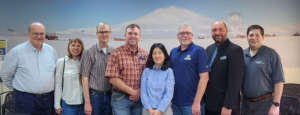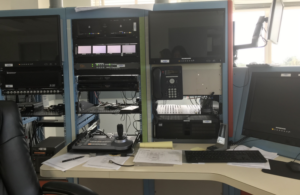by Jieun Chang
On a bright and clear morning of October 6, a team of academics from Southwestern Oklahoma State University (SWOSU) embarked on an educational journey to the Columbia Scientific Balloon Facility (CSBF) in Palestine, Texas. This expedition was initiated by Dr. Mickey Slimp, the executive director of the Great Plains Network, and arranged by the Hibbs Institute for Business Economic Research at the University of Texas at Tyler. The team included Dr. Jerry Dunn, an expert in agricultural economics, Dr. Jeremy Evert, a computer science specialist, Mr. Colton Parkinson, an engineering technology expert, and myself, with a specialization in economics, along with Dr. Pierre Neuenschwander, a biotechnology researcher from UT Tyler.

Upon arrival at the CSBF, we joined Dr. Mickey Slimp, Dr. Pierre Neuenschwander, UT Tyler Biotechnologist, and other guests at the visitor center. The CSBF is a facility steeped in history. Established in 1961 as the National Scientific Balloon Facility in Boulder, CO, it relocated to Palestine, Texas in 1963. In 2006, it was renamed to honor the courageous crew of the Space Shuttle Columbia’s 2003 mission. Today, it serves as a hub for scientific discovery, offering comprehensive balloon operations services and engineering support to researchers worldwide.
Our exploration of the facility was guided by Mr. Alan Buckland. Over the course of three hours, we were introduced to the marvels of scientific ballooning. Mr. Buckland explained the history of the CSBF and helped us understand the significance of scientific balloon research through videos and articles displayed on the wall in the visitor center.
We learned about various scientific balloon projects and their equipment. We were also introduced to public misconceptions such as UFO sightings that are often mistaken for scientific balloons. The grandeur of these projects was further emphasized by pictures of scientific balloon launches at Antarctica displayed on another wall.
One of the highlights of our visit was observing the launch vehicle and imagining the flurry of activity during a balloon launch. We learned that the balloon system includes the balloon itself, the payload, and a parachute. Mr. Buckland handed out a small piece of plastic bag and explained that balloons are made from a polyethylene film that’s just 0.0008 inches thick but capable of supporting a complete balloon system.



We also visited other facilities across the street including a launch site, testing site, and ground telemetry station. When balloons are launched in various locations around the world such as Sweden, New Zealand, and Antarctica, data is routed back to CBSF via satellite link. At the Long Duration Balloon Operation Control Center, we had an opportunity to witness a meeting among engineers. This underscored the importance of advanced computing systems and satellite connections for scientific research and local economic growth.




During our visit to the CSBF, we learned about the crucial compatibility tests conducted to ensure seamless operation between science systems and control systems. These tests play a pivotal role in ensuring the success of balloon projects.


We also had the opportunity to visit the Palestine Ground Telemetry Station, where we were treated to an aerial view of the launch site. This experience deepened our appreciation for scientific exploration and the pursuit of knowledge.


After our enlightening tour, we found ourselves reflecting on our experience at a local restaurant adorned with NASA stickers, a testament to the facility’s significant influence on this small town. Our conversation naturally veered towards the potential economic impact of such a facility in our hometown – Weatherford, Oklahoma.
Weatherford is home to SWOSU and the esteemed Stafford Air & Space Museum, named after Weatherford’s own Lt. General Thomas P. Stafford, a legendary test pilot and astronaut. The parallels between Palestine and Weatherford sparked an invigorating discussion about the potential influence of scientific research on our local economy.
Reflecting on Lt. General Stafford’s collection at the SWOSU library, the prominence of the Stafford Museum, and Oklahoma’s growing aerospace industry, we began envisioning potential R&D opportunities. We saw potential collaborations between various entities such as the Stafford Museum, local schools, Tinker Air Force Base, and local businesses in research activities.
For sustained research activities, it became clear that a robust research and education network would be indispensable – one that includes improved bandwidth and cloud systems. The prospect of fostering cooperation among researchers from diverse fields was indeed an exciting thought.
